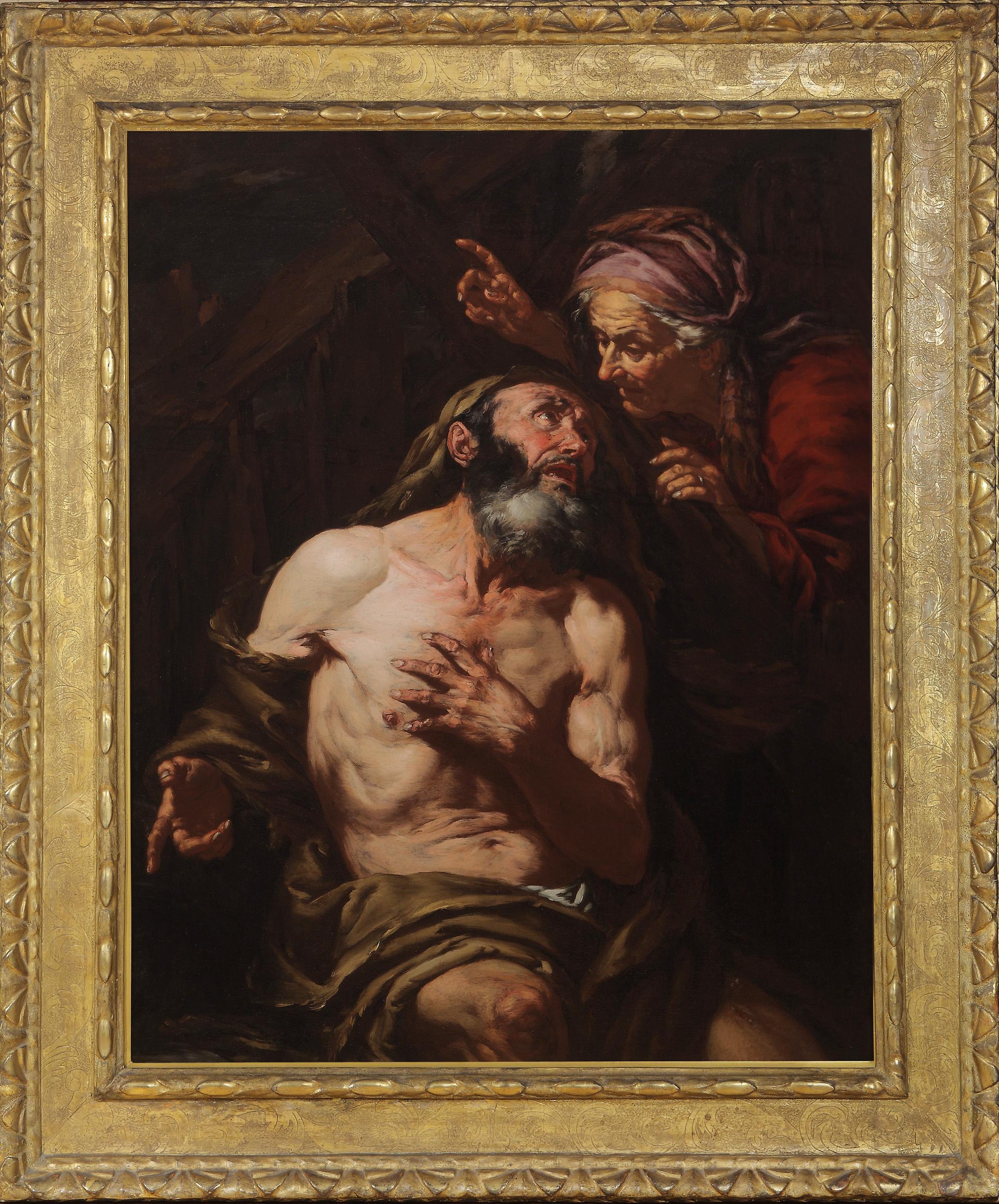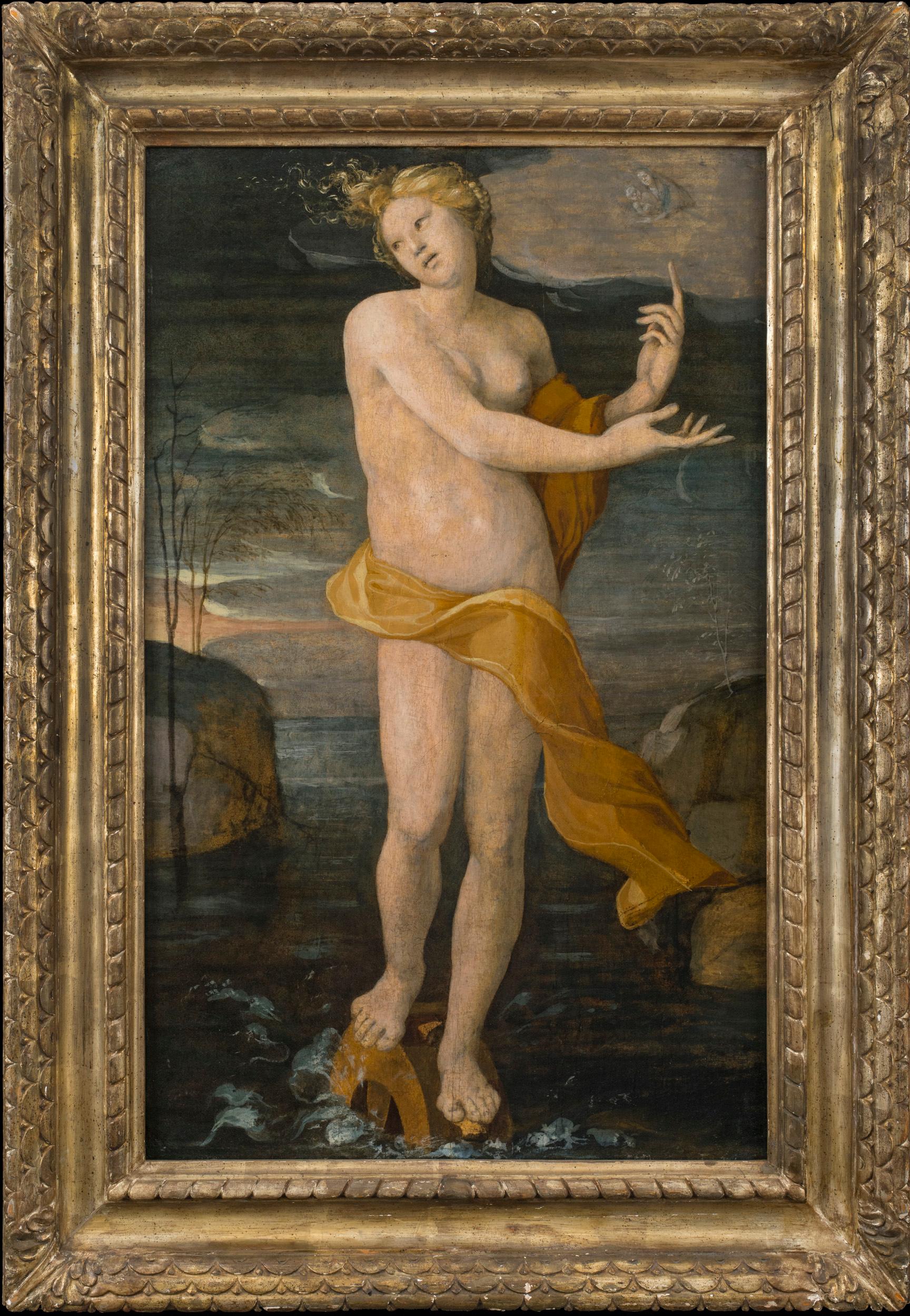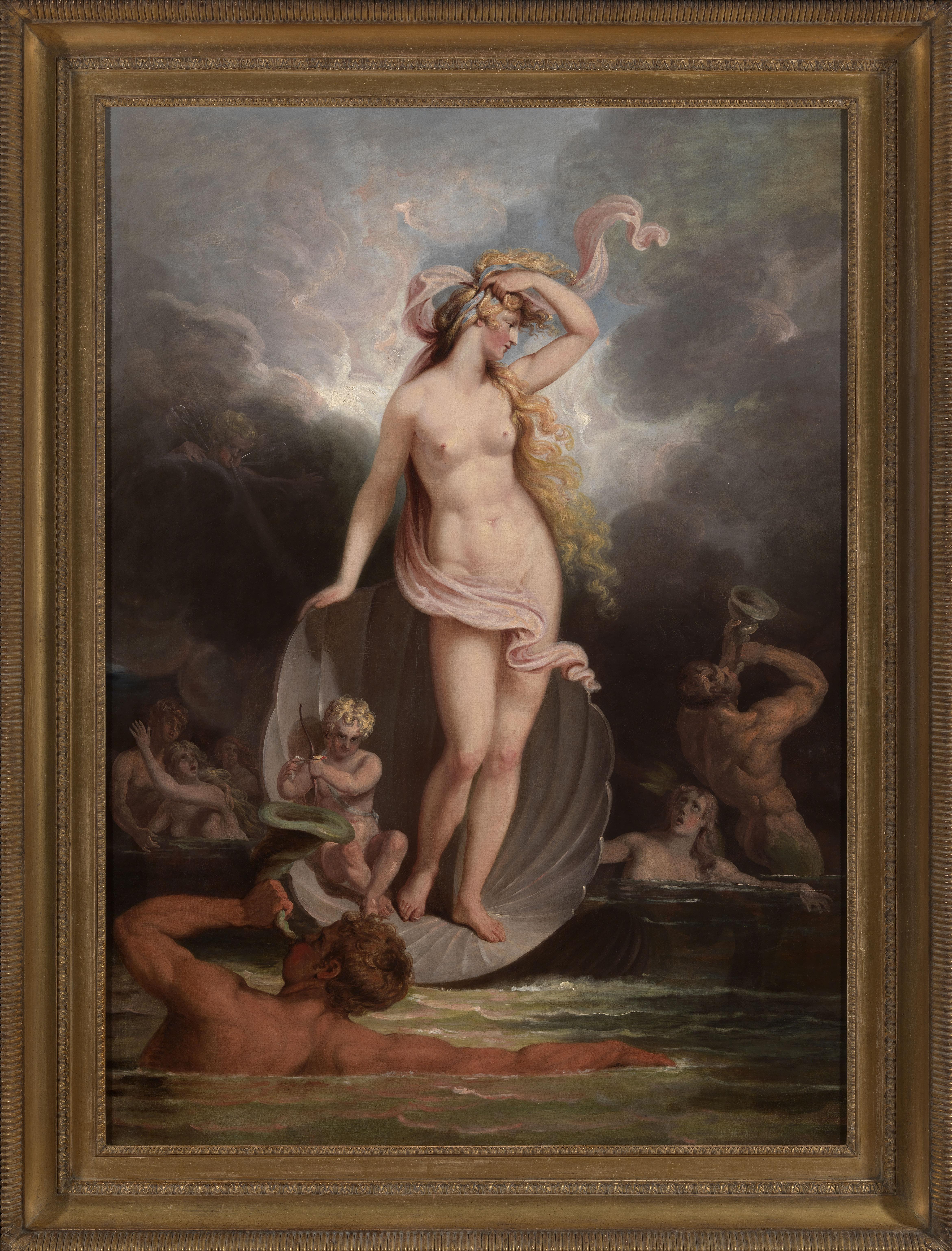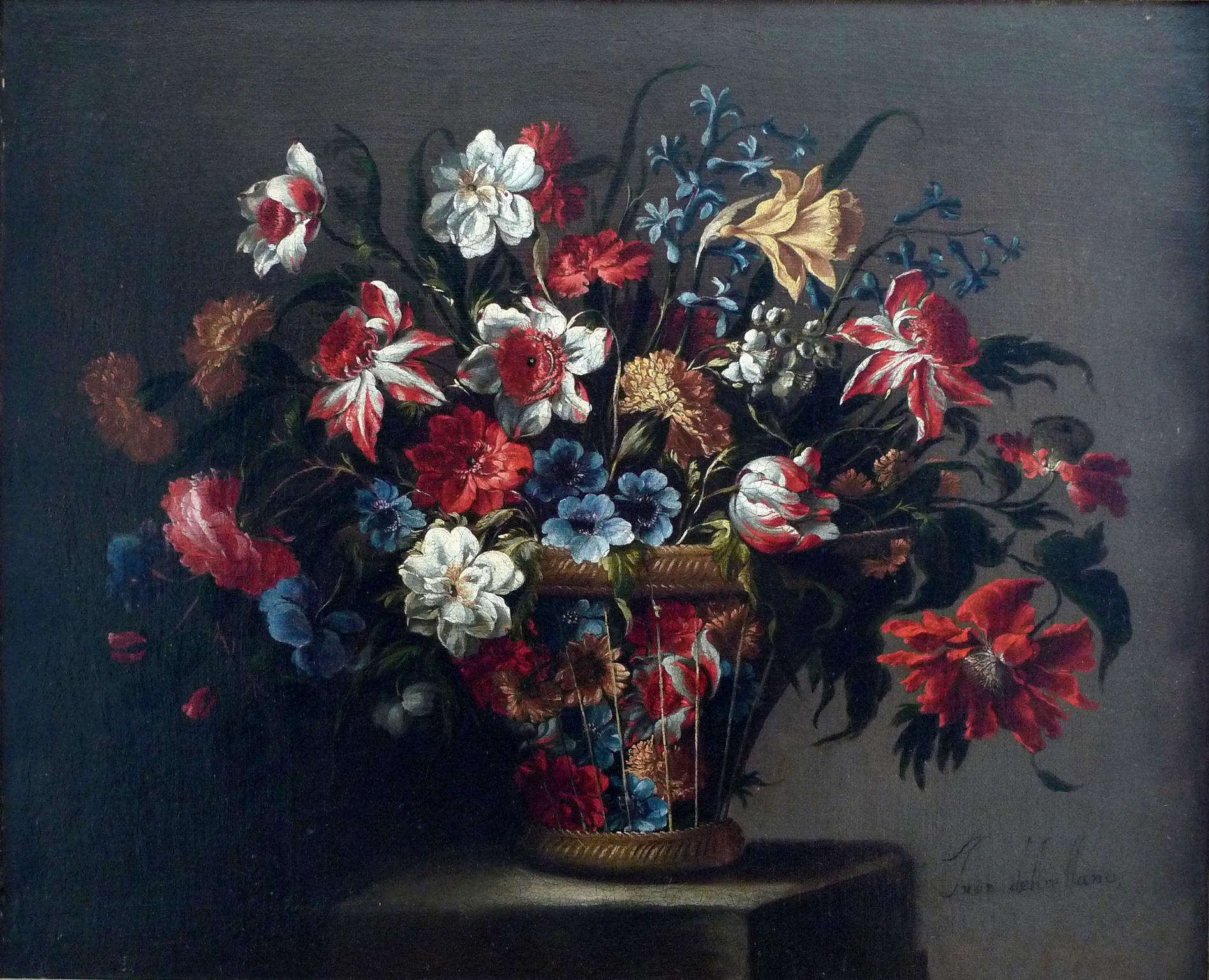Items Similar to Angels Floral Garland Maratta Paint Oil on table Old master 17th Century Italian
Want more images or videos?
Request additional images or videos from the seller
Angels Floral Garland Maratta Paint Oil on table Old master 17th Century Italian1697
1697
About the Item
Pair of angels with floral garland and cartouche with family motto 'Pulchriora latent'
Workshop of Carlo Maratta (Camerano, 1625 - Rome, 1713)
Dated on parchment, right: 1697
oil on the table (94 x 84cm./ in frame 105 x 95 cm.)
This magnificent composition, depicting two little fluttering cupids intent on holding up a garland of flowers, can be traced back, both for the stylistic characteristics and for the compositional taste, to a master active in the fervid seventeenth-century Baroque Rome.
One of the two cupids is about to grab the bow of the garland with his head facing downwards, while with the other hand he shows a parchment which bears, in addition to the date of execution, the Latin expression "Pulchriora latent" ("The the most beautiful things are hidden"), which could probably recall the motto of the commissioning family. A second winged putto, perched on a cloud, watches the scene clutching the other end of the garland, richly decorated with various types of flowers, enriching the composition with a piece of still life of excellent quality.
The iconography that sees putti with flowers represented is frequent in the Baroque period, especially in Rome, congenial to the new bourgeois class, who wanted more illusionistic and frivolous images for their residences, and therefore aspired to a type of paintings with a strong decorative value , depicting jubilation of cherubs, angels or cherubs, and of which our table represents an emblematic example.
Going into the detail of the composition, his design invention as well as the stupendous lighting and chromatic effects lead us to link his authorship to the inventive flair of the workshop of Carlo Maratta (1625 - 1713). Note how the soft roundness of the playful cherubs, the brushstroke that defines the flowing hair and their soft complexions, are characteristic elements of his art.
In particular, it is useful to recall the series of paintings commissioned in 1692 by the banker Francesco Montioni for his palace in Rome (Opere di palazzo Montioni, Rome: link), and which Maratta himself executed with the collaboration of his pupil Franz Werner von Tamm (1658-1724). Again in collaboration with Tamm, Carlo Maratta repeated these compositions for the Marquis Nicolò Maria Pallavicini.
This still life iconography immediately found an echo among Roman collectors, and was therefore replicated and varied on numerous occasions. Among these the 'Garland of flowers with cupids' (Sotheby's, London, 6 July 1994, n. 115), finds correspondences with our painting:
A particularity that makes this work unique is that the panel is also painted on the back with two vertical ornaments with acanthus leaf motifs, which seem to have been carved in the 'trompe l'oeil' style. One could assume their original function as doors for a chamber organ.
Excellent state of conservation.
ADDITIONAL INFORMATION:
The work is sold with a certificate of authenticity and a descriptive iconographic sheet.
We take care of and organize the transport of the purchased works, both for Italy and abroad, through professional and insured carriers.
It is also possible to see the painting in the Riva del Garda gallery, we will be happy to welcome you to show you our collection of works.
Contact us, without obligation, for any additional information.
- Creation Year:1697
- Dimensions:Height: 41.34 in (105 cm)Width: 37.41 in (95 cm)
- Medium:
- Movement & Style:
- Circle Of:Carlo Maratta (Camerano, 1625 - Rome, 1713) (1625 - 1713)
- Period:
- Condition:
- Gallery Location:Riva del Garda, IT
- Reference Number:1stDibs: LU988111526872
About the Seller
4.8
Platinum Seller
These expertly vetted sellers are 1stDibs' most experienced sellers and are rated highest by our customers.
Established in 2017
1stDibs seller since 2018
202 sales on 1stDibs
Typical response time: <1 hour
- ShippingRetrieving quote...Ships From: Riva del Garda, Italy
- Return PolicyA return for this item may be initiated within 7 days of delivery.
More From This SellerView All
- Deposition Atala De Roussy-trioson Paint Oil on canvas 19/20th Century FrenchLocated in Riva del Garda, ITThe deposition of Atala Follower of Anne-Louis Girodet de Roussy-Trioson (Montargis, 1767 - Paris, 1824) 19th-20th century Oil on canvas 47 x 65 cm. - Framed 67 x 84 cm The propos...Category
Late 19th Century Old Masters Paintings
MaterialsOil
- De Wit Flowers Still life Paint Oil on canvas 18th Century Flemish Cupids ArtLocated in Riva del Garda, ITJacob De Wit (Amsterdam, 1695 - 1754) attributable/ workshop Pair of Cupids with Garland of Flowers Oil on canvas 91 x 103 cm. - Framed 104 x 115 cm. Provenance: Christie's (London, Old master Painting 12.12.1996) lot 82 This magnificent composition depicts two cupids holding a garland of flowers, placed on a fine architecture with bas-reliefs and masks, presumably the top of a fountain. One of the two cupids sympathetically holds a part of it with his hands, while his head turns towards the viewer; the second cupid, on the other hand, must have clumsily broken the thread holding its end, and is sitting sullenly with a torch and a tear streaking his chubby cheek. The work, given its stylistic features and compositional taste, can be attributed to the Flemish artist Jacob de Wit (Amsterdam, 1695 - 1754), or to an artist from his workshop, with his typical triumphal and opulent style, which reveals clear influences from Rubens and Van Dijck, but also from Gerard de Lairesse...Category
18th Century Old Masters Paintings
MaterialsOil
- Perroneau Portrait Lady Woman Paint Oil on canvas 18th Century Old master FrenchLocated in Riva del Garda, ITJean-Baptiste Perroneau (Paris, 1715 – Amsterdam, 1783) Portrait of a lady Oil on oval canvas 60 x 50 cm. - In frame 77 x 66 cm. Work accompanied by expertise: Raffaelle Colace (Cremona), Ferdinando Arisi Reference bibliography: d’Arnoult, Dominique (2014) Jean-Baptiste Perronneau, c 1715-1783, un portraitiste dans l’Europe des Lumières Excerpt from the expertise of Dr. Colace: This refined portrait of a lady is a perfect example of the style of Jean-Baptiste Perroneau, a very talented French painter, whose most beautiful works are located, just like this one, between the fifth and sixth decades of the eighteenth century. "Perroneaeu is more naturally colored than La Tour, the est, in the peinture de poussière colorée, tout plein de tons clairs, frais, presque humides": this is how his brothers wrote about him in La Maison d...Category
18th Century Old Masters Paintings
MaterialsOil
- Battle Horsemen Landscape Graziani Paint Oil on canvas 17th Century Old masterLocated in Riva del Garda, ITFrancesco Graziani, known as Ciccio Napoletano (active in Naples and Rome in the second half of the 17th century) Battle with clash of horsemen Oil on canvas 95 x 130 cm In period ...Category
17th Century Old Masters Paintings
MaterialsOil
- Terwesten Woman Allegory Art Paint Oil on canvas 17/18th Century Old masterLocated in Riva del Garda, ITMattheus Terwesten (The Hague, 1670 - 1757) Portrait of a young woman with palette and brushes, as Allegory of the art of Painting Oil on canvas 160 x 91 cm. - In frame 178 x 107 cm...Category
17th Century Old Masters Paintings
MaterialsOil
- Storm See Water Landscape Vernet 18th Century Paint Oil on canvas Old masterLocated in Riva del Garda, ITClaude-Joseph Vernet (Avignon, 1714 - Paris, 1789) workshop of The Storm on the Lighthouse 1750/60 Technique: Oil on canvas Dimensions: 48 x 67 cm / framed 77 x 93 cm We share a highly pleasing work, a splendid marine executed by a talented painter from the workshop of the Frenchman Claude-Joseph Vernet, depicting a coastal view set in a Mediterranean port with the sea still stormy. The focal point of the composition is the large lighthouse at the entrance to the port, which, due to the power of the sea, was unable to bring to safety the ship that had crashed against the rocks, while the silhouette of a second sailing ship can be glimpsed in the distance. The canvas shows in full the pictorial, chromatic and narrative characteristics of the great master Vernet's coastal landscapes, characterised by the inimitable atmospheric conditions always hovering between darkness and light, storm and calm, instilling the observer with contrasting feelings, made even more intense by a palette of vibrant and highly contrasting colours. A similar composition, from which our author must necessarily have drawn, also attributed to the workshop of Claude Joseph Vernet is to be found in France, in Nantes, at the Musée d'Arts.  The effects of the light create a visual drama in the contrast between the darkness of the rain-laden storm clouds and the gash of clear sky that is opening up, pierced by the timid rays of light. The real magic of the painting is the painter's highly personal use of light and colour, with chiaroscuro effects that accentuate its three-dimensionality and movement. The compositional typology, as well as the quality of execution and attention to detail we are dealing with, are typical elements of the 'prototypes' conceived by the master, later taken up around the middle of the 18th century by his best pupils. Similar versions can be found in the most important international museums and private collections, belonging to a large series of paintings that the master created, together with his collaborators, during his stay in Italy. Vernet lived in Rome for twenty years (1734 - 1753), becoming particularly popular with English aristocrats who stopped there on their Grand Tour. International fame followed him from Rome to France, and to his English and French clients he added German princes...Category
18th Century Old Masters Paintings
MaterialsOil
You May Also Like
- Job Cursed by His WifeBy Giovanni Battista LangettiLocated in New York, NYProvenance: Alfred (1883-1961) and Hermine Stiassni (1889-1962), Brno, Czech Republic, by 1925; thence London, 1938-1940; thence Los Angeles, 1940-1962; thence by descent to: Susanne Stiassni Martin and Leonard Martin, San Francisco, until 2005; thence by descent to: Private Collection, California Exhibited: Künstlerhaus, Brünn (Brno), 1925, as by Ribera. “Art of Collecting,” Flint Institute of Art, Flint, Michigan, 23 November 2018 – 6 January 2019. Literature: Alte Meister...Category
1670s Old Masters Paintings
MaterialsCanvas, Oil
- Portrait of a Lady with a ChiqueadorLocated in New York, NYProvenance: Torres Family Collection, Asunción, Paraguay, ca. 1967-2017 While the genre of portraiture flourished in the New World, very few examples of early Spanish colonial portraits have survived to the present day. This remarkable painting is a rare example of female portraiture, depicting a member of the highest echelons of society in Cuzco during the last quarter of the 17th century. Its most distinctive feature is the false beauty mark (called a chiqueador) that the sitter wears on her left temple. Chiqueadores served both a cosmetic and medicinal function. In addition to beautifying their wearers, these silk or velvet pouches often contained medicinal herbs thought to cure headaches. This painting depicts an unidentified lady from the Creole elite in Cuzco. Her formal posture and black costume are both typical of the established conventions of period portraiture and in line with the severe fashion of the Spanish court under the reign of Charles II, which remained current until the 18th century. She is shown in three-quarter profile, her long braids tied with soft pink bows and decorated with quatrefoil flowers, likely made of silver. Her facial features are idealized and rendered with great subtly, particularly in the rosy cheeks. While this portrait lacks the conventional coat of arms or cartouche that identifies the sitter, her high status is made clear by the wealth of jewels and luxury materials present in the painting. She is placed in an interior, set off against the red velvet curtain tied in the middle with a knot on her right, and the table covered with gold-trimmed red velvet cloth at the left. The sitter wears a four-tier pearl necklace with a knot in the center with matching three-tiered pearl bracelets and a cross-shaped earing with three increasingly large pearls. She also has several gold and silver rings on both hands—one holds a pair of silver gloves with red lining and the other is posed on a golden metal box, possibly a jewelry box. The materials of her costume are also of the highest quality, particularly the white lace trim of her wide neckline and circular cuffs. The historical moment in which this painting was produced was particularly rich in commissions of this kind. Following his arrival in Cuzco from Spain in the early 1670’s, bishop Manuel de Mollinedo y Angulo actively promoted the emergence of a distinctive regional school of painting in the city. Additionally, with the increase of wealth and economic prosperity in the New World, portraits quickly became a way for the growing elite class to celebrate their place in society and to preserve their memory. Portraits like this one would have been prominently displayed in a family’s home, perhaps in a dynastic portrait gallery. We are grateful to Professor Luis Eduardo Wuffarden for his assistance cataloguing this painting on the basis of high-resolution images. He has written that “the sober palette of the canvas, the quality of the pigments, the degree of aging, and the craquelure pattern on the painting layer confirm it to be an authentic and representative work of the Cuzco school of painting...Category
17th Century Old Masters Paintings
MaterialsCanvas, Oil
- Allegory of FortuneLocated in New York, NYProvenance: S. Spinelli Collection, Florence; their sale, Galleria Pesaro, Milan, July 11-14, 1928, lot 112 (unsold); reoffered Galleria Luigi Bellini, Florence, April 23-26, 1934, lot 132, as manner of Baldassare Peruzzi Dr. Giacomo Ancona, Florence, 1930s, and after 1939, San Francisco; thence by descent to his son: Mario Ancona, San Francisco; thence by descent to his children: Mario Ancona III and Victoria Ancona, San Francisco, until 1995; thence to: Phyllis Ancona Green, widow of Mario Ancona, Los Angeles (1995-2012) Literature: Donato Sanminiatelli, Domenico Beccafumi. Milan 1967, p. 170 (under paintings attributed to Beccafumi) Among the precious survivors of Renaissance secular paintings for domestic interiors are several unusual and particularly attractive panels painted in Siena at the end of the fifteenth and beginning of the sixteenth centuries. These paintings depict exemplary figures from antiquity—heroes or heroines, as well as allegorical, literary, and mythological figures. For the most part, these panels have survived in groups of three, although it is possible that some of these works were painted either as part of larger series or as individual projects. One such trio by Beccafumi consists of two paintings now at the National Gallery, London (Marcia and Tanaquil) and a third in the Galleria Doria-Pamphilj, Rome (Cornelia). These were commissioned around 1517–1519 for the bedroom of Francesco di Camillo Petrucci in Siena and were most likely placed together as elements in the wall decoration (spalliere) or installed above the back of a bench or cassapanca. Another, earlier (ca. 1495–1500), set of three—Guidoccio Cozzarelli’s Hippo, Camilla, and Lucretia (Private Collection, Siena) survives with its original wooden framework—a kind of secular triptych. Judith, Sophonisba, and Cleopatra in the collection of the Monte dei Paschi, Siena, are by an anonymous artist close to Beccafumi called the “Master of the Chigi-Saracini Heroines.” Girolamo di Benvenuto’s Cleopatra, Tuccia, and Portia are dispersed (homeless, Prague, Chambery), and Brescianino’s Faith, Hope, and Charity are in the Pinacoteca Nazionale in Siena. The present painting first appeared in the Spinelli sale in Florence in 1934, at which time it was sold with two panels of identical size and format. Each was catalogued as being by the “manner of Baldassare Peruzzi” and of unidentified subject. Of these, the painting depicting a male figure turned to the right has recently reappeared in a private Italian collection, while the location of the third work, portraying a cloaked figure turned three-quarters left, remains unknown. Our panel depicts the allegorical figure of Fortune. Here she is represented in typical fashion as a nude female figure balanced on a wheel (sometimes called the Rota Fortunae), her billowing drapery indicating that she is as changeable as the wind. The appearance of the Virgin and Child in the cloud at the upper right is an unusual addition to the iconography. The subjects of the two pendant male...Category
16th Century Old Masters Paintings
MaterialsOil, Panel
- 18th century allegorical painting of The Triumph of BeautyLocated in London, GBExhibited: London, Royal Academy, 1800, no. 93 What was happening in British history painting in around 1800? In recent discussions of the emergence of a British School of history painting following the foundation of the Royal Academy in 1768, this is a question which is rarely posed and one which is not easily answered. Examination of surviving Royal Academy exhibition catalogues reveals a profusion of artists’ names and titles, few of which remain immediately recognizable, whilst endeavours to explain the impact of exhibition culture on painting - such as the 2001 Courtauld show Art on the Line - have tended to focus on the first and second generation of Royal Academician, rather than young or aspiring artists in the early nineteenth century. This makes the discovery and identification of the work under discussion of exceptional importance in making sense of currents in English painting around 1800. Executed by Edward Dayes...Category
18th Century Old Masters Figurative Paintings
MaterialsCanvas, Oil
- Virgin and Child, a paiting by David Teniers the Younger after Palma VecchioBy David Teniers the YoungerLocated in PARIS, FRProvenance: Dukes of Marlborough Collection, Blenheim Palace until its sale at Christie's London on 26 July 1886 (lot 172) English private collection until its sale at Christie's London on 11 December 1992 (lot 363) Erna Weidinger Collection (1923 - 2021) - Austria Literature : Georg Scharf - A list of the pictures in Blenheim Palace - Catalogue raisonné Part 2 - London 1862 (page 166 - number 199 "after Palma Giovane") Charles Davies...Category
1750s Old Masters Figurative Paintings
MaterialsOak, Oil
- "Cesta de flores", 17th Century Oil on Canvas, Still Flowers by Juan de ArellanoBy Juan de ArellanoLocated in Madrid, ESJUAN DE ARELLANO Spanish, 1614 - 1676 Cesta de Flores signed Juan de Arellano (lower lright) oil on canvas original period carved, gilt and polychrome...Category
17th Century Old Masters Still-life Paintings
MaterialsCanvas, Oil
Recently Viewed
View AllMore Ways To Browse
Old Paint
Master Piece Art
How Old
Antique Floral Art
Painting Italy Rome
Italian Painting Rome
Italian Master Painting
Paintings Of Rome Italy
Old Beautiful Paintings
Old Master Style
Oil Paintings Rome
Oil Paintings Of Rome
Italian Masters Oil
Old Masters Italy
Paintings Italian Old
Rome Paintings Framed
Angels Paint
Painted Angels





